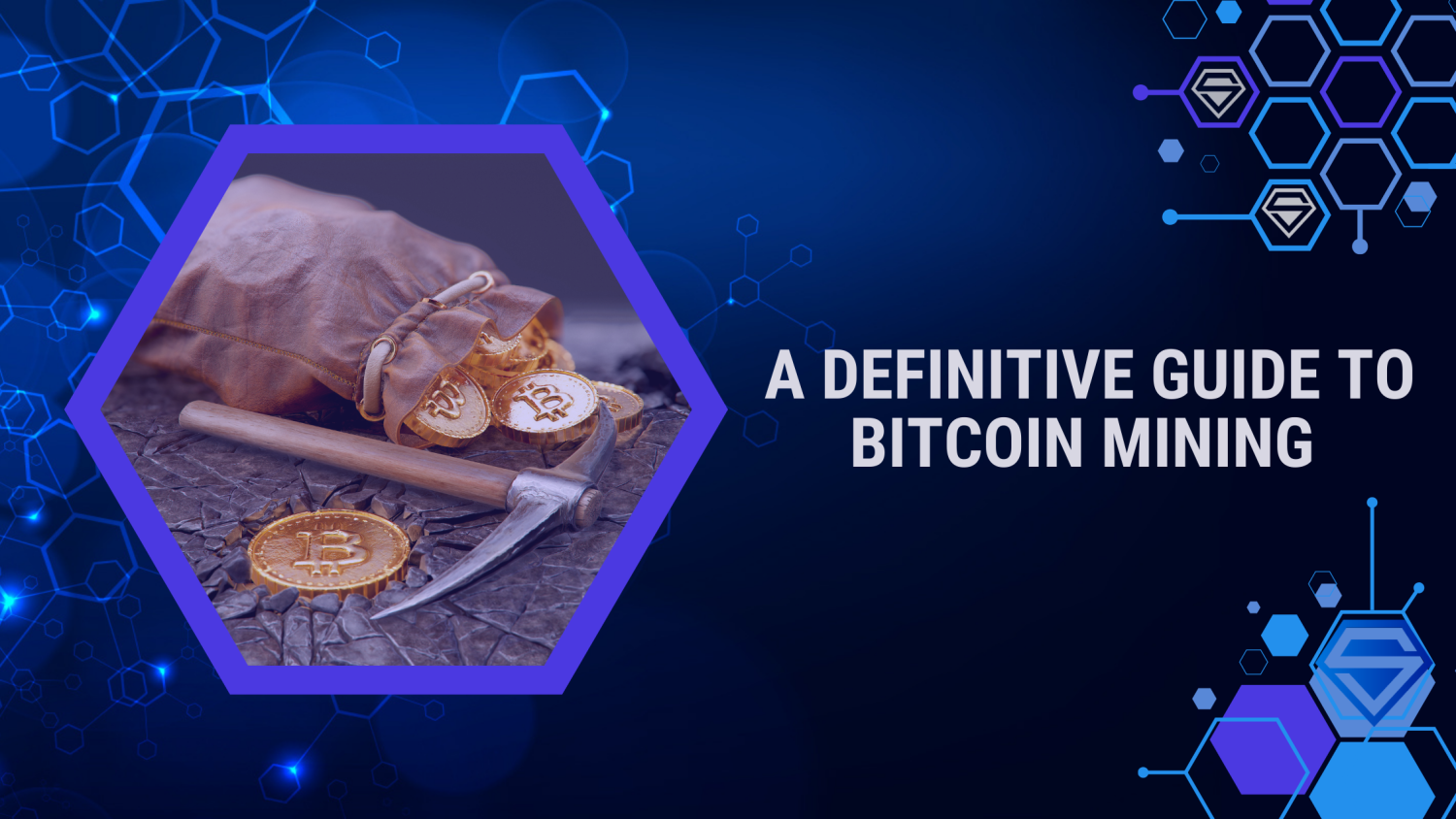
16. October, 2023
What is Bitcoin Mining: A Comprehensive Guide
In an era where digital currencies have revolutionized the way we think about money, Bitcoin has emerged as a pioneer and a buzzword in the world of finance and technology. At the heart of this groundbreaking cryptocurrency lies a complex and intriguing process known as Bitcoin mining.
But what exactly is Bitcoin mining, and why is it so crucial to the functioning of this decentralized digital currency? If you’ve ever found yourself pondering these questions, you’re in the right place.
In this comprehensive guide, we will embark on a journey into the world of Bitcoin mining. Whether you’re a beginner or a seasoned crypto enthusiast, prepare to delve deep into Bitcoin mining, where digital currencies and the blockchain converge to redefine the future of finance.
What is Bitcoin Mining?
At its core, Bitcoin mining is the heartbeat of the entire cryptocurrency ecosystem. It’s the mechanism responsible for two critical functions: the creation of new Bitcoins and the secure recording of all transactions on the blockchain. In many ways, you can think of it as the engine that powers the vast network of Bitcoin.
Now, you might wonder, who are the individuals behind this intricate operation? Well, they are none other than miners – the unsung heroes of cryptocurrency. Miners are akin to digital treasure hunters, navigating the complex maze of cryptographic puzzles in the pursuit of digital gold.
Miners play a pivotal part in upholding the integrity and security of the Bitcoin network. When Bitcoin transactions occur, they are bundled together into blocks, which are, in turn, added to the blockchain – a decentralized ledger of all Bitcoin transactions. Miners validate these transactions and ensure they’re legitimate, preventing double-spending and fraudulent activities.
Getting Started with Bitcoin Mining
Now that you’ve grasped the fundamental concept of Bitcoin mining, you’re likely eager to dive into the world of the digital gold rush.
Hardware: The Power of Machines
At the heart of Bitcoin mining is the hardware, the essential machinery that performs the complex mathematical calculations necessary to validate and secure transactions on the network.
We will delve into various hardware options, each with its unique set of advantages and drawbacks:
- ASIC Miners: Application-Specific Integrated Circuits, or ASICs, are the elite soldiers of the mining world. Highly specialized and incredibly efficient, these machines are purpose-built for Bitcoin mining, leaving little room for alternatives.
- GPUs (Graphics Processing Units): For those seeking a more versatile and cost-effective approach, GPUs offer a middle ground. They can be used for a variety of tasks beyond mining and are often the choice for miners with a broader interest in cryptocurrency.
- CPUs (Central Processing Units): While less common today, CPUs can still be employed for mining, especially for those just getting started or experimenting with smaller-scale operations. CPUs are suitable for learning and experimenting, but they are not cost-effective for serious mining due to their limited computational power.
Selecting the right hardware depends on your budget, mining goals, and electricity costs. ASIC miners are typically the most profitable but also the most expensive, while GPUs offer a more versatile option for those who want to mine multiple cryptocurrencies.
Software: Choosing the Right Mining Software
Once you have your hardware, you need suitable mining software to connect your devices to the Bitcoin network. The choice of software depends on your hardware type:
- ASIC Miner Software: ASIC miners typically come with their own built-in software. However, you can choose from various third-party software options that might provide additional features and customization.
- GPU and CPU Mining Software: For GPUs and CPUs, you have a broader range of options. Some popular choices include CGMiner, BFGMiner, EasyMiner, and NiceHash. Your choice should be based on compatibility with your hardware and your personal preferences.
It’s essential to stay updated with software developments, as the landscape can change rapidly due to updates and improvements. Compatibility, ease of use, and efficiency are key factors to consider when selecting mining software.
Mining Pools: Joining Forces for Increased Rewards
While solo mining is possible, it’s often more practical to join a mining pool. Mining pools are groups of miners who combine their computational power to increase their chances of solving mathematical problems and earning rewards. When a pool successfully mines a block, the rewards are distributed among pool members based on their contributed computing power.
Popular Bitcoin mining pools include F2Pool, Slush Pool, and Antpool. Each pool has its payout structure, fees, and minimum payout thresholds, so it’s crucial to research and select the one that aligns with your preferences and objectives.
Wallets: Safely Storing Your Bitcoins
After successfully mining Bitcoins, it’s vital to store them securely. Bitcoin wallets are digital tools that allow you to manage and store your cryptocurrency. There are two main types of Bitcoin wallets:
- Hot Wallets: These are online wallets that are connected to the internet. They are convenient for everyday transactions but can be vulnerable to hacks if not properly secured.
- Cold Wallets: Also known as a cold storage wallet, it is a type of cryptocurrency wallet that is not connected to the internet. They are typically used for long-term storage of cryptocurrency and are considered one of the most secure methods for safeguarding your digital assets.
The Mining Process
To appreciate the intricacies of this process, one must delve into the nitty-gritty of how it all works.
Mining Difficulty
Bitcoin’s protocol automatically adjusts the difficulty of mining to maintain a consistent block production rate of approximately one every ten minutes. This process ensures that new blocks are not mined too quickly or too slowly, regardless of the total computational power dedicated to mining.
Mining difficulty is a critical parameter for miners to consider, as it directly impacts the amount of computational power required to mine a block successfully.
Hash Rate
The hash rate is a fundamental concept in Bitcoin mining. It represents the computational power of the entire network, measured in hashes per second (H/s). Hashing is the process of verifying and adding transactions to the blockchain, and the speed at which these calculations are performed is crucial for successful mining.
Significance of Hash Rate
Understanding the significance of the hash rate is vital for miners. A higher hash rate means more computational power in the network, resulting in a more secure and efficient blockchain. It also implies increased competition among miners, which can make it more challenging for individual miners to earn rewards.
To put it simply, a higher hash rate provides a greater chance of successfully mining a block and reaping the associated rewards. However, it also means that miners must invest in more powerful hardware to remain competitive.
Bitcoin Mining Rewards
Bitcoin mining is not just a technological endeavor; it’s also a lucrative one. Understanding how these rewards work is crucial for miners who want to maximize their earnings.
Block Rewards
Block rewards are the primary source of income for Bitcoin miners. These rewards are the incentives miners receive for successfully adding a new block to the blockchain. When Bitcoin was first created, the block reward was set at 50 BTC per block. However, as part of the network’s design, these rewards are halved approximately every four years.
The halving event that occurred in May 2020, it reduced the block reward to 6.25 BTC per block. The next halving event is expected to take place in 2024, further reducing the reward. As a result, miners must find ways to compensate for the decreasing block rewards.
Transaction Fees
In addition to block rewards, miners also earn transaction fees. When users send Bitcoin, they can include a transaction fee as an incentive for miners to prioritize their transactions. The higher the fee, the more likely it is that the transaction will be included in the next block.
Transaction fees vary depending on network congestion and the urgency of the transaction. Miners can earn a substantial income from transaction fees, especially during times of high demand and network activity.
Bitcoin Halving Events
Bitcoin halving events have a significant impact on mining rewards. As mentioned earlier, the block rewards are halved approximately every four years, reducing the number of new bitcoins generated with each block. The purpose of these halvings is to control the supply and prevent inflation, but they also have implications for miners.
Each halving event makes it more challenging for miners to earn the same number of bitcoins for their efforts. However, it can also increase the value of existing bitcoins due to reduced supply, potentially offsetting the reduction in block rewards.
Mining Challenges and Sustainability
Bitcoin mining, while a critical aspect of the cryptocurrency ecosystem, has faced increasing scrutiny due to its environmental impact and energy consumption.
Environmental Concerns
One of the most significant challenges facing Bitcoin mining is its environmental impact. The process relies on energy-intensive computations, typically powered by electricity generated from various sources. Traditional energy sources, such as coal and natural gas, contribute to greenhouse gas emissions, making the industry a target for environmental critics.
However, it’s important to note that the cryptocurrency community is actively exploring more sustainable alternatives, including renewable energy sources like solar and wind power. Some mining operations are relocating to regions with abundant clean energy, thereby reducing their carbon footprint.
Energy Consumption
The energy consumption of Bitcoin mining is a concern due to its exponential growth. The network’s security relies on miners solving complex mathematical problems, which require an enormous amount of computational power. As a result, Bitcoin mining consumes a significant amount of electricity, which can strain local power grids and impact overall energy availability.
Efforts are underway to improve the energy efficiency of mining hardware, and the adoption of green energy sources can help mitigate these concerns. Additionally, some mining pools and companies are exploring innovative cooling techniques and reducing waste heat, which can make the process more energy-efficient.
Impact of Regulations
While some countries have embraced and regulated the industry, others have imposed stricter regulations or even banned mining activities altogether.
Regulatory changes can significantly affect the mining industry, impacting the location of mining operations, tax obligations, and compliance with environmental standards. Miners need to stay informed about the evolving regulatory environment in their region and be prepared to adapt their operations accordingly.
Conclusion
Bitcoin mining, with its blend of technical sophistication and economic opportunity, is a subject that requires a comprehensive understanding. This guide aims to address the pain points, unravel the complexity, and provide you with a smart, formal, and easy-to-understand journey through the world of Bitcoin mining. As the cryptocurrency landscape continues to evolve, this knowledge will empower you to make informed decisions and participate in this exciting digital frontier.


